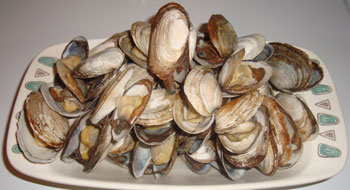Clams Ahoy!
Everything you always wanted to know about Clams but were afraid to ask!!
Steamed Clams
Steamed clams, also called steamers, are wonderful. In fact many saltwater mollusks are not just suitable to human consumption, but delicious.
One of these is not the cockle. Cockles have beautiful, ribbed shells, and have taken over Cape Cod beaches in recent years. They can be steamed easily, but taste unpleasant, bitter and nasty in every way. Anyone who’s eaten a cockle can understand why for the Irish, they were “famine food,” a last resort when potatoes and seaweed had been exhausted. No one would eat a cockle unless he had to. But oysters, mussels, and clams, all these taste great and are easy to cook in different ways.
Let’s discuss the steamer, the most renowned clam popular on the East Coast.
Softshell clams
Known as steamers, Mya arenaria, from how they are cooked. Steamers can be raked, but this most often breaks the fragile shells. Steamers are best dug by hand. They are common to many East coast beaches, particularly those with less surf, and live anywhere from three inches to twelve inches below the surface. Most not far below the surface, at least not most that are harvested.
One goes steamer clamming at low tide, because at high tide their habitat, always close to the tide line is under water. Often a small hole about the size of this capital “O” will reveal a steamer just below it in the sand. Stomp the sand, and you may see jets of water come out of these holes. That’s a sure sign a steamer is below. Gloves are not necessary, in fact they will hamper your efforts because clamming is tactile. A clam can sense you feeling his shell and will respond by digging away from you. This sounds ridiculous until you almost have a grip on the thing and then lose it, repeatedly. Expect to get mucky. Wear rubber boots and slicker pants if you can. A good haul of steamers is maybe 50-60 clams. Most towns have local shellfishing license requirements – check at the local town hall or municipal building. By tradition, you will receive a round steel ring. Clams that fit through the ring are undersize, and should be reburied. The easiest way to prepare delicious steamers is to first rinse your clams in fresh water, to remove sand and grime. Soak the clams overnight in seawater, with a sprinkle of cornmeal thrown in – this will encourage the clams to spit out any sand inside them overnight. Don’t forget this step, or you will hear complaints from your guests!
The next day, dump the seawater and place the clams aside. Add a half-inch of water to the steamer pot and bring it to a full boil. This always takes longer than you expect. Once the water is boiling, add the clams, taking care not to crack any shells. Leave the clams at full boil until most of the shells have popped open. Generally the steamers will be cooked, and ready to eat, when 85% or so of the shells have opened. This will take a very few minutes. If most of the shells have opened, it should be safe to eat them. Those with unopened shells should open after taking off the heat as they continue to cook. A clam that hasn't opened either is not cooked quite enough or no good. Always smell a clam you’re not certain of first. If it doesn’t smell good, don’t eat it!
 Pour out the broth into a second pan and save it. Meantime microwave a
small amount of butter, and distribute small bowls of broth and butter on
the table. Eating steamers works this way: separate the shells and remove
the meat. Remove the dark neckcollar from the clam’s neck, along with any
associated muck around the white-to-pale-yellow meat. Hold each meat by the
neck, dip first into the broth, then into the butter and then into your
mouth! It does take some courage to eat your first steamer, they are
strange-looking to say the least, but sweet to the taste, with delicious
hints of the sea. A typical serving of steamers includes 7-10 clams. Serving
steamers is an excellent way to introduce your guests to the traditional
cuisine of the New England, Mid-Atlantic and Southern coastal states.
Ambitious folks will want to learn more about the clambake, an all-day
affair in which a giant pit is dug in the sand, then filled with
seaweed-covered stones, steamers on top, which are covered with more seaweed
then lobsters layered at the very top. A clambake is the traditional Cape
Cod, Long Island and Maine summer entertainment, but that’s a story for
another time.
Pour out the broth into a second pan and save it. Meantime microwave a
small amount of butter, and distribute small bowls of broth and butter on
the table. Eating steamers works this way: separate the shells and remove
the meat. Remove the dark neckcollar from the clam’s neck, along with any
associated muck around the white-to-pale-yellow meat. Hold each meat by the
neck, dip first into the broth, then into the butter and then into your
mouth! It does take some courage to eat your first steamer, they are
strange-looking to say the least, but sweet to the taste, with delicious
hints of the sea. A typical serving of steamers includes 7-10 clams. Serving
steamers is an excellent way to introduce your guests to the traditional
cuisine of the New England, Mid-Atlantic and Southern coastal states.
Ambitious folks will want to learn more about the clambake, an all-day
affair in which a giant pit is dug in the sand, then filled with
seaweed-covered stones, steamers on top, which are covered with more seaweed
then lobsters layered at the very top. A clambake is the traditional Cape
Cod, Long Island and Maine summer entertainment, but that’s a story for
another time.
If you'd like, you can skip the clam broth and butter too if you are a clam lover. And other types of clams besides softshell clams can also be steamed as long as they are small in size, but they are not traditional "steamers."
 Hi,
we are Ted and John, just two guys who love Clams and other seafood.
Hi,
we are Ted and John, just two guys who love Clams and other seafood.